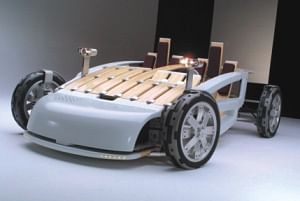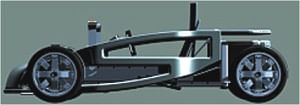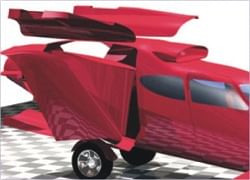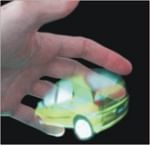If
cars got weirder
Compiled
by Gokhra
So what do you
want to call it? Weird? Ugly? Beautiful even? Come to think of it,
is it a car? Oh wait, it has four wheels. Well, you reactions are
as mixed as anyone else's.
 The
vehicle is called MA, named for the Asian philosophy of "the
space between." The philosophy refers to a kind of threshold
where two concepts can exist in a mutually beneficial relationship.
As a car, the MA represents the same idea, occupying a space between
emotional and rational, art and science. It does have a minimalist
attraction to it.
The
vehicle is called MA, named for the Asian philosophy of "the
space between." The philosophy refers to a kind of threshold
where two concepts can exist in a mutually beneficial relationship.
As a car, the MA represents the same idea, occupying a space between
emotional and rational, art and science. It does have a minimalist
attraction to it.
"The MA,
with its architectural, minimalist appearance, poses what an automotive
aesthetic might look like in the future," said Ford Motor Company
Vice President of Design J Mays. "This car is hard to pin down
- and that's what the MA is all about. It's about proposing solutions
that are not obvious, that are between our traditional visions for
a car."
Designed totally
on a computer, the MA uses a futuristic combination of materials:
bamboo, aluminum and carbon fiber. The car has no welds. Instead,
364 titanium bolts hold the MA together. So how do you repair it after
a close encounter with a rickshaw?
Environmental
responsibility plays a key role in the MA. Bamboo, a regenerative
grass (also easily available attached to a "thela gari")that
grows back every five years, figures prominently in the open-air design.
Only a few parts are painted. There are no hydraulic fluids and none
of the industrial adhesives typically used in automobiles, making
the MA more than 96 percent recyclable. The MA concept uses a zero-emission,
low-speed electric engine that has virtually no environmental impact.
However, the car could also be outfitted with a small conventional
gasoline engine.
 The
MA is targeted at younger customers looking for new interpretations
of an automobile. The MA's low-slung, aerodynamic wedge shape and
mid-engine balance conjure up images of a two-seat, neighborhood sports
car. Instead of being produced in a plant, the vehicle comes in a
more than 500-piece kit, ready for assembly. At the MOCA exhibit,
the MA will be displayed both as a completed car and as a kit of individual
pieces ready for assembly.
The
MA is targeted at younger customers looking for new interpretations
of an automobile. The MA's low-slung, aerodynamic wedge shape and
mid-engine balance conjure up images of a two-seat, neighborhood sports
car. Instead of being produced in a plant, the vehicle comes in a
more than 500-piece kit, ready for assembly. At the MOCA exhibit,
the MA will be displayed both as a completed car and as a kit of individual
pieces ready for assembly.
Ford has a come
up with a lot of mind blowing concepts like the GT40, Fortynine and
the GT90 but this? Go figure!
Sci-Zone
By
Dr Freak
 Tiny
Telescope Finds Giant Planet
Tiny
Telescope Finds Giant Planet
Fifteen years ago, the largest telescopes in the world had yet to
locate a planet orbiting another star. Today telescopes no larger
than those used by amateur star-gazers are proving capable of spotting
previously unknown worlds. A newfound planet detected by a small,
4-inch-diameter telescope demonstrates that we are at the cusp of
a new age of planet discovery. Soon, new worlds may be located at
an accelerating pace, bringing the detection of the first Earth-sized
world one step closer. This is the very first extra-solar planet discovery
made by a dedicated survey of many thousands of relatively bright
stars in large regions of the sky. The newfound planet is a Jupiter-sized
gas giant orbiting a star located about 500 light-years from the Earth
in the constellation Lyra. This world circles its star every 3.03
days at a distance of only 4 million miles, much closer and faster
than the planet Mercury in our solar system, giving it a temperature
of around 1500 degrees F. Astronomers used an innovative technique
to discover this new world. It was found by the "transit method,"
which looks for a dip in a star's brightness when a planet crosses
directly in front of the star and casts a shadow. A Jupiter-sized
planet blocks only about 1/100th of the light from a Sun-like star,
but that is enough to make it detectable. Who knows what you may find
while gazing at the sky with a small telescope?
Movies
On Holographic Discs
Optware Corp., the developer of Collinear Holographic Data Storage
System, recently announced that it had achieved successfully world's
first recording and play back of digital movies on a holographic recording
disc with a reflective layer using Optware's revolutionary Collinear
Holography. This is a major milestone for commercializing holographic
data storage system. Optware's holographic recording technology records
data on discs in the form of laser interference fringes, enabling
existing discs the same size as today's DVDs to store as much as one
terabyte of data (200 times the capacity of a single layer DVD), with
a transfer speed of one gigabyte per second (40 times the speed of
DVD).
 A
Flying Leap for Cars
A
Flying Leap for Cars
That's right, efforts to take personal transportation airborne are
progressing rapidly. "Air taxis" will come first. George
Jetson made it look so easy in the toons. The '60s-vintage TV-cartoon
character would step from the bedroom of his sky-platform apartment
onto a moving walkway to his flying car. And it would whisk him off
to work. Back in the real world, even decades later, we can only wish.
But not for long, as flying cars are suddenly becoming less of a pipe
dream or the stuff of cartoons. Giants including carmakers Honda and
Toyota are developing prototypes of small flying devices. Helped by
advances in nanotechnology, microelectronics and robotics, researchers
from NASA, Carnegie Mellon University, and University of Florida are
developing new flight-related technologies, designed to make piloting
an aircraft easier than driving a car. In theory, as everyone begins
flying to work, these contraptions could dwarf today's $850 billion
auto industry. The devices ranging from air taxis to personal flying
machines could breathe life into aerospace companies' growth or create
a whole new generation of start-ups. Best of all, some versions of
this vision could start to come true within several years. Air taxis,
which would carry from four to eight passengers on shorter rides between
smaller, now-underused airports, could become available in the next
three to four years. Following in the footsteps of several start-ups,
Honda has developed an experimental jet-powered air taxi, now in flight
testing. In February, it announced it would manufacture, together
with General Electric the economical jet engine Honda developed for
the plane. With $75 billion in annual sales, the Japanese carmaker
could eventually enter the promising air-taxi business as well. With
air taxis whizzing overhead, personal flying cars' arrival will only
be a matter of time. Just wait and see.
Jaw
Transplant Gets Hi-tech
A German man has been able to savour his first proper meal in nine
years after surgeons successfully created and transplanted a jawbone
for him. A jaw, grown on a titanium frame, enabled the man to chew
for the first time since he lost his lower jaw in radical surgery
for cancer. The functional jawbone was created using a combination
of computer aided design and bone stem cells. The doctors at the University
of Kiel in Germany created a titanium mesh cage to a three-dimensional
shape and fit, for his lower jaw, using computer-aided design, based
on CT scans of his face. The mesh was then filled by bone mineral
blocks, recombinant human bone morphogenic protein powder and liquid
bone marrow containing stem cells. The titanium frame was then implanted
into a layer of muscle on the patient's right shoulder blade to form
tissue and blood vessel connections to the muscle. Seven weeks later
the implant was removed, delivering a new jaw-structure, which was
then transplanted and connected with the existing upper jaw.
